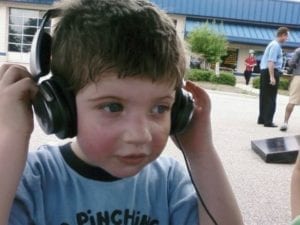
I was driving my 13-year-old son Teddy to school about a month ago and listening to the morning show on one of our local radio stations. Out of nowhere, he turned to me and said, “Let’s call the station.” Turns out he was interested in requesting a song and seeing if there was a contest to play.

Radio DNA – My son Teddy trying on my Sony MDR-V600 headphones at a station remote in 2009.
This question surprised me on a number of levels.
- Like many teenagers, he’s generally more invested in watching videos on YouTube than listening to the radio;
- When he does listen to music, it usually involves navigating his Spotify playlist or playing records (yes, records) at home;
- He’s never expressed interest in calling a radio station before.
He further surprised me by knowing the phone numbers of the stations by heart. He punched in the number of the one we were listening to. Knowing the possibilities on the other end of the line, I prepped him a bit. “Morning shows are really busy, so it’s possible they won’t answer.”
Ring…ring…ring…and that’s what happened with the first station. No answer, no voicemail, no nothing. Just ringing.
He mentioned another station and asked to call that show. Sure, why not.
Ring…ring…ring…no answer. No voicemail.
Rinse and repeat with a few other stations until there were no other stations the boy was interested in talking to.
In every single instance that morning, at every radio station he called, there was no response. Just ringing.
My first reaction was disappointment for him. When I was his age, I called radio stations all the time for the same reason. And usually, someone picked up the phone. I made requests on the CHR stations. Gave opinions on the sports talk station. Some of my idols were DJs. Those phone calls inspired me to want to be one of them.
So here we are in 2020, trying to figure out ways to keep radio relevant for younger generations. Meanwhile, a 13-year-old gets the urge to call a local radio station and no one picks up. Guess how many times he’s tried again since?
You know the answer.
This really struck me when I arrived at the office and discussed this with Matt Bailey of Integr8 Research, our sister company. It’s not the fact that no one was available to answer the phone that bothered us – that’s unavoidable.
It’s the fact that, despite all the tech we have available now, radio stations are just letting the phone ring when a listener is actually calling to engage!
I covered radio’s long-standing “I’ll see what I can do” attitude in a December blog post, challenging stations to do better when listeners make requests. But now I wonder, just how many opportunities to engage listeners are we leaving on the table?
What if, when a listener calls your radio station and the jock is unavailable, it goes to a recording of whoever is on-air at that time (schedule the recordings in sync with the air schedule) letting the caller know they can’t pick up the call right away but encouraging the caller to leave a message with a request? Or a question? Or feedback? Why aren’t we taking this opportunity to record testimonials for promos?
This can be customized. The jocks can toggle between being available to talk live and when they need the voicemail backup. Instead of voicemail, if it won’t be long, ask the caller to wait on hold for a minute. During that hold, the caller can listen live or listen to a promo.
Can your station app have a “Talk to Control Room” button that automatically allows for this recording if the station can’t be reached? Or one that goes to chat instead?
Keeping consumers interested in radio must involve dissecting every point of contact and removing points of possible friction. The request line is one friction point.
Hopefully, my son will get the urge to call a station again. But I guarantee if he just gets ringing, there won’t be a third time.
